It was a good idea. Or so we thought.
After a day spent chasing bones and tarpon on the flats of Chetumal Bay, instead of heading back to the lodge, Earl and I asked our guide, Alejandro, to drop us on the beach in Xcalak, a modest little Yucatan fishing village that fronts the Caribbean just north of the border with Belize.
It was somewhat of an usual request, but our plan to wander the friendly little community, find a cold cerveza and maybe a couple plates of tacos pescados to share was enough to entice
a couple of the other guests at The Xflats, a hidden-in-plain-sight fly-fishing lodge a few kilometers north of town, to join us.
After exploring town, we’d walk the gnarly dirt road back to the lodge and be there in time for dinner number two. If you know Earl, you know there’s no such thing as a single dinner. He’s like a hobbit (“What about elevensies?”). He’s where meals go to die. Once, while in the Bahamas, after we’d enjoyed a perfectly lovely meal at the lodge where we were staying, well past dark on Long Island, Earl convinced us to wander up the road to a local palapa bar, where we enjoyed Second Dinner — a conch burger, fries, and a few more chilled Kaliks.
The four of us followed Earl’s nose through the charming streets of Xcalak. Everyone we crossed paths with was quick to offer up a smile and a friendly, “Hola!” People in small, off-the-beaten-path communities in Mexico are like that — friendly for no good reason other than being otherwise never crosses their minds. About the only thing we noticed about Xcalak that we didn’t love was the mosquitoes. But they loved us.
As we walked through town swatting the bloodsuckers off our bare arms and legs, we were joined by a friendly, stray perro who wandered right up to the taqueria with us. We wandered in, found a table and ordered a round of cold beers with some fish tacos to go around. A couple of ceiling fans overhead provided enough of a breeze to give us a break from the bugs. Our little brown mongrel of a mutt wandered around outside the restaurant after being scolded by the proprietor.

As an avid angler and someone who enjoys the cultural aspect of traveling — I’ve always thought that diving into a new and different culture poses an opportunity to expand my limited worldview — I consider it almost dutiful to get to know the place I’m visiting. You’ll likely never find me at an all-inclusive seaside resort where folks never leave the property and stare at their next “authentic” meal through a sneeze-guard while they’re in line at the buffet. To me, that’s a plastic vacation.
Xcalak is the real Yucatan. Modest. Unassuming. Friendly. Drop-dead beautiful.
After we downed a couple beers each and inhaled the delicious fish tacos from the quiet little taqueria, we started our walk. The little stray kept time, and followed us through the town market as we worked our way back to the lodge. The mosquitoes identified the four helpless white guys wandering a lonely stretch of gravel and by the time we got to the outskirts of town on the little dirt road through the jungle, we were under attack. We picked up the pace. Our adopted pooch followed along.
It took a good 40 minutes to get back to the lodge — maybe a 3-mile jaunt. And it would have been a perfectly lovely stroll if we hadn’t spent it constantly wiping blood-bloated mosquitoes off of our arms and legs. By the time we arrived at the gate of the lodge and its manicured grounds, the journey had turned into a speed-walking race, and we were much less enamored with our ingenious plan to hoof it from Xcalak. There was only one tonic to take our minds off the welts that were swelling up on our exposed skin: rum poured liberally over ice and enjoyed under the lodge’s spacious palapa dining room and bar. I added a squeeze of lemon to the drink, and then rubbed the juice from my fingers onto the fresh bites.

Ah … relief.
And the dog? One of the lodge staffers immediately recognized him. Moments later, he was scooped up and carried back to town — and his rightful owner — on the back of a little scooter.
Adiós, perro. Vaya con dios.
Chetumal Bay
Chetumal Bay is the southernmost bay on the Mexican Yucatan — it’s situated south of both Ascension Bay and Espiritu Santo Bay, both of which are likely better known among the saltwater fly-fishing community. Mexico shares Chetumal Bay with Belize, and it might be the Yucatan’s best-kept secret.
And Chetumal is huge. It’s bigger than Ascension and Espiritu Santo combined. Chetumal is fed by the outflow of the Hondo River, which forms the border between Mexico and Belize. The bay’s south-facing mouth is contained by Ambergris Cay on the east and by the mainland on the west. Because of its size, there’s an almost endless array of fishable habitat to choose from. On any given day, guides from The Xflats can point the noses of their pangas through a little canal that connects the Mexican portion of the bay with the Caribbean and in minutes have a client on the bow looking for bonefish or permit. Or, they can burn some fuel and wander north into the bay’s remote regions, where more flats, more mangrove haunts and hidden cenotes offer anglers shots at nice-sized bonefish, schools of permit and even tarpon that can range from babies in the 8- to 10-pound class to 100-pound monsters that’ll shatter an 8-weight.
My visit to The Xflats was my second to Xcalak and to Chetumal Bay. I took a DIY trip to the area a few years back, when I got my first taste of the area’s bones and tarpon. But I was largely footbound then. I did rent a kayak and venture into a couple of seaside lagoons, but my only real fishing in the bay happened when I found a guide on the beach in town willing to take me out for the day.
Five years later, that same guide, Nato — an Xcalak fly-fishing legend known locally as Don Nato — piloted us through the canal and off into the bay in search of bonefish and permit. As we cut through the canal, the clear Caribbean waters revealed a host of inshore fish. We motored over big schools of bonefish migrating between the bay and the sea, and permit, too, moved through the little fishy highway. Mangrove and mutton snappers lurked under mangrove limbs and held tight to the rocks along the canal. We marveled at the sheer numbers of fish, and part of me wanted to turn to Nato and simply ask, “Why aren’t we fishing here?”

But the seasoned guide grew up on a mangrove cay in the middle of the bay, and even now, as he gets older and a little more grizzled from his years under the Yucatan sun, he has a plan.
“We’re going to find the bigger bonefish,” Nato said in his raspy, accented English, as we slid over a 100-strong school of 3-pounders moving through the canal. He waved his hands dismissively at the fish scurrying out from under his panga. “These aren’t the bigger ones.”
The southern Yucatan, for bonefish, anyway, is largely a numbers fishery — it’s not home to really big bones that can push 10 pounds like you might find in the Bahamas. A 5-pound fish along the Mexican Riviera or Costa Maya is a trophy. Are there bigger fish? Certainly. But they’re not common.
As we poked out of the canal, Don Nato put the hammer down and off we went to look for the gray ghost of Chetumal Bay.
The fishing
Arriving to The Xflats, we were greeted by the departing group. The lodge had just commenced hosting its annual guide week, and the assembled bunch of anglers from all over the U.S. had put dozens of permit on the board. The stories they shared left us magnifying both our expectations and our skillsets. Basking in the limelight of their tales, we were lulled to sleep our first night at the lodge by dreams of the permit we hoped to—or rather, would—catch on Chetumal Bay's flats.
But first, we’d shake the rust off chasing the bay’s bonefish. Under the tutelage of Nato or fellow guide Alejandro (nicknamed Balbino), we found the bonefish to be plentiful. More importantly, we found them to be amenable. In fact, even with some inclement weather and wind which moved in on our second day at the lodge, Earl and I enjoyed one of the best bonefish weeks I think either of us has ever experienced. Credit the guides for knowing where the sheltered flats are and how to get out of the wind and the chop of the big, shallow bay.
On our first day, Nato pushed us up tight against a mangrove island and I hopped up to the bow, a 7-weight in hand.

“Look right up against the mangroves,” Nato said. His assistant guide, Jose, stood right behind me and helped me peel about 60 feet of line off my reel in anticipation of a quick cast. And it didn’t take long. Jose and I saw the pair of cruising bones moving along the edge of the stubby mangroves at about the same time. I pointed my rod, and Jose pointed his finger.
“Yes,” he said. “Cast.”
I’d been farther north in the Yucatan for a week and I was already in saltwater mode. I flipped a solid cast right in front of the cruisers, and everything came together just as it was supposed to. We’d been chasing bonefish for five minutes, and already we were taking photos of a beautiful 4-pound fish that pounced on a Gotcha without an instant of hesitation.
“Is it gonna be like this all week?” Earl asked from the stern of the boat.
Jose kind of grinned.
“This is life with Don Nato,” he said.
Earl and I traded places, and just a few minutes later, he, too, was posing with a nice bone. The fish seemed to appear out of nowhere, and the bigger specimens were in smaller groups — two, three or four fish. Occasionally, they’d get a little skittish, but, so long as you didn’t line them or plop the fly right on top of them, they almost always showed sincere interest. And, even when they spooked, they were quick to chill – I caught several bonefish on second and third casts that, at first, I threw out of desperation at retreating fish. Balbino preached patience when I startled a nice bonefish with a cast that was just too close.
“Cast again,” he said, pointing at the fish that was now moving away from the boat. “About 10 feet in front of it.”
I made the cast, and, sure enough, the big bonefish followed the stripped fly and sucked it in. Balbino just grinned. Between the two of us, we caught several “second-chance” fish.
It may sound a bit unreal, especially for anglers who have plied the waters of the Keys or the Bahamas for bonefish, but it felt as though anglers chasing bones in Chetumal Bay could catch them at will.

As for the permit, the shower of good fortune that flowed for the group that preceded our week at the lodge, all-too-predictably, ran dry. Perhaps the universe had decided to issue a stipend to the group of fishing guides — a well-earned payment for a season of patiently dealing with the bird’s-nest tangles, poor casting and unreasonable expectations of sports back on their home waters. Or, more likely, permit fishing is permit fishing. Even when you put your time in on the bow, as we did, sometimes the stars refuse to align. There’s a reason that pursuing permit is widely regarded not just as an addiction, but as an affliction, of anglers the world over.
But seeing is believing when judging the prospects of a permit fishery. Shortly after pushing off the dock on our first day, we saw schools of permit feeding along the sea-side beach, their sickle-like tails slicing through the green water over beds of turtle grass. Groups of a dozen or more fish seemed pretty common, but every attempted cast seemed to fall short or, even worse, splash down right in their faces and send the saucer-shaped giants sprinting for deeper water.
Throughout the week, in between sojourns to chase Chetumal Bay's tarpon, snook, barracuda and oversized jack crevalle, we frequently saw schools of permit, many of which held sizable fish. But it wasn't meant to be.
No matter. We saw. Not only the names adorning the “permit wall” back at the lodge, or the countless photos of smiling Chetumal Bay anglers posing with trophy permit, but the schools and the sickle tails that frequently spiked our heart rates as we stood on the bow of a panga that week.
We believe. And we’ll be back to Chetumal Bay to try again.
If you go
Getting There
Guests visiting Xcalak and Chetumal Bay fly into Cancun International Airport (CUN). From there, DIY anglers can rent a car or take public transportation — though utilizing the bus system to make your way to Xcalak requires an all-day bus trip to Chetumal City, an overnight stay, and a second bus to Xcalak the following day. If you’re planning on visiting a lodge, most lodges include shuttle service as part of their weekly rate, with pickup at Cancun International Airport or a hotel in Cancun, should your flight arrive too late in the day for the drive south.
Choosing a Lodge/Outfitter
As the only lodge in or around Xcalak that caters specifically to anglers, The Xflats will be the destination of choice for most fly fishers. The lodge offers a great mix of comfort and Caribbean charm (and air-conditioned rooms). Its staff is attentive, meals are excellent and the guides have forgotten more about Chetumal Bay than you’ll ever know. There are other choices, but they tend to be hybrid outfits that cater to divers, kayakers and a few anglers.
When To Go
Anytime. Seriously. Even in high summer, The Xflats is open to visiting anglers, and that’s because there’s always something going on. Spring and fall can be great bonefish months, and the permit are around all year. Tarpon move out of the bay into the cooler Caribbean all summer long, and other fish, like barracuda, big jacks and snappers can be caught any month of the year..
Other Options
If fishing is just part of your vacation, consider a visit to Mahahual. It’s on the way to Xcalak, and is quite a bit bigger. Unfortunately, at least as far as I’m concerned, it’s also home to a significant cruise port (Costa Maya). Thankfully, the matching-belt-and-shoes crowd rarely leaves the manufactured tourist plaza north of town. Sure, a few might venture into Mahahual and wander the malecon, but its remote feel still hangs on. Beachfront hotels are available and generally affordable. Plus, the bay inside the reef (which is visible from town) is an excellent fishery for everything from jacks and snappers to bonefish and even permit.




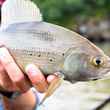
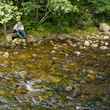
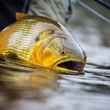
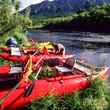








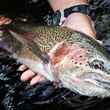
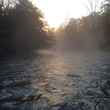



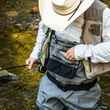




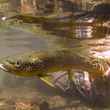
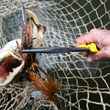

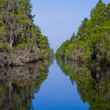
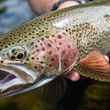
Comments
Bolderado replied on Permalink
Great Article! Xcalak is all that you say it is and much more as have been there a few times. The guides are excellent and reasonably priced. For lodging, I like Acocote Eco Inn. The proprietor, Rob Mukai is an excellent fly fisherman in his own right and a superb host! best, bolderado
Pages